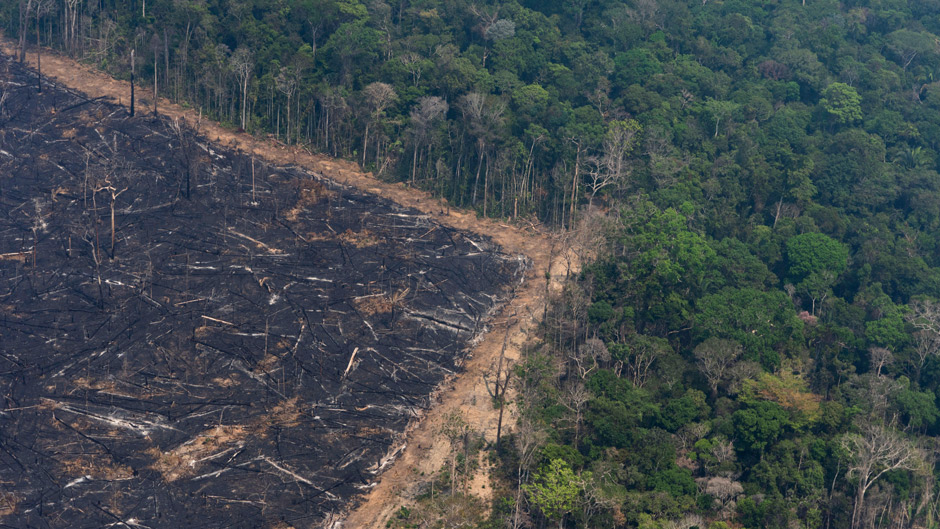The Amazon rainforest is burning at a record rate. So far this year, almost 73,000 fires in Brazil have been detected—an 85 percent increase from last year. This could have major impacts on the global climate, environmentalists warn.
Kenneth Feeley, who is the Smathers Chair of Tropical Trees in the Department of Biology at the University of Miami College of Arts and Sciences, said the Amazon plays several vital roles for humans.
“The Amazon regulates the Earth’s climate. One way it does it is through carbon dioxide. The Amazon is a huge storehouse of carbon," said Feeley. “By burning the forests you release the stored carbon into the atmosphere, exacerbating the greenhouse effect and ultimately increasing how fast the Earth warms up.”
Roni Avissar, dean of the Rosenstiel School of Marine and Atmospheric Science, is a climatologist who has studied the Amazon and how deforestation affects precipitation patterns around the world.
“Continual deforestation could trigger the modification of rainfall almost all over the planet,” he said. “If we continue on this path, we are going to reach a tipping point where the damage may be irreversible.”
The Amazon is also home to thousands of species, making it one of the most biodiverse locations in the world.
“If the Amazon keeps burning, we will inevitably loose many forms of species. Most plants and animals depend on having intact ecosystems, but as we degrade and destroy the Amazon, we increase the risk of species going extinct,” Feeley said.
Professor José Maria Cardoso da Silva, chair of geography and regional studies in the College of Arts and Sciences mapped the distribution of narrowly distributed plant species in the Brazilian Amazon to estimate their extinction risks. He and his research team found that there are 298 species of seed plants in 168 areas that altogether cover 10% of the Brazilian Amazon. Among these species, almost 73% (216) are projected to be under high extinction risk by the end of the century due to habitat loss, climate change, or both, assuming that their areas will not lose any habitat in the future due to land use.
His research suggests that deforestation and climate change can lead to mass extinction of species in tropical ecosystems and that “tropical countries, such as Brazil, should integrate biodiversity conservation and climate change policies (both mitigation and adaptation) to achieve win-win social and environmental gains while halting species extinction.”
Farmers and cattle ranchers who are continually clearing land for crops and livestock are setting many of the wildfires burning today.
“It’s all based on supply and demand,” said Feeley. “Brazil has one of the least efficient cattle industries on the planet. They are raising just one or two cows per hectare of what used to be rainforest. Until we decrease the demand for beef and other products coming out of deforested lands, there’s no way to stop it.”
Cardoso da Silva, who is Brazilian, stated that the fires have also been caused as a result of anti-environmental attitudes that have been adopted by current Brazilian President Jair Bolsonaro.
“Brazil has made big progress in the last decades setting policies that have reduced the deforestation in the region. However, the current president’s rhetoric has sent the message to the society that the protection of the Amazon and other Brazilian ecosystems is not a priority in his government,” he said.
Bolsonaro is also facing criticism for the way his government has sought to take over indigenous lands. Tracy Devine Guzman, associate professor of Latin American studies at the University, said the situation of indigenous people in Brazil was dire long before the outset of this current tragedy. She said that the administration has failed to enact any policy to ensure indigenous wellbeing.
“The result of this disaster for indigenous peoples, alongside other residents of the Amazon whose social, economic, and cultural well-being is grounded in and derives from a respectful, sustainable co-existence with the natural world, is nothing short of an existential threat,” she said. “Indigenous people have promised to defend themselves and their lands till their last breath.”
Caleb Everett, professor and chair of the Department of Anthropology in the College of Arts and Sciences, said this is alarming because they are seeing some of their homelands go up in smoke.
“I’ve been in Amazonia with indigenous people during the burning seasons, and it certainly affects some of them in very negative ways, threatening some of their homelands. Among other things, it impacts their hunting,” he said.
Although the fires in the Amazon have recently been getting a lot of media attention, Feeley reminded people that the burning of the Amazon has been happening for decades.
“These kinds of fires happen all the time. What is surprising to me is how much media attention it is now getting, and that is a good thing. It shows the potential of what the media can do to raise awareness and hopefully to spur real change,” he said.
Feeley believes we as a global community have a choice to make.
“There are different paths that we can follow at this point. If people take their anger and turn it into action, then this tragedy can lead to a positive move forward,” said Feeley. “If we just let this pass with another news cycle and then forget about it, then the burning and deforestation is going to happen again next year and again the year after that. At some point the forest will not be able to regenerate or recover, and we will all have to face the consequences.”

